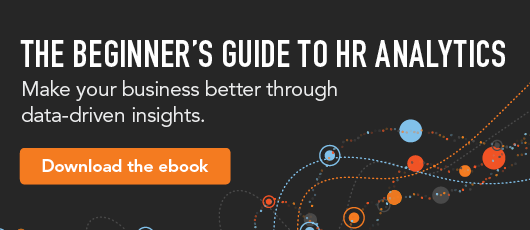What is HR Analytics and Why Is It Important?
 You’re told to create data-driven HR practices, but you might not feel like you have the analytical chops to get there. You’re not alone!
You’re told to create data-driven HR practices, but you might not feel like you have the analytical chops to get there. You’re not alone!
A recent study by Deloitte says that while 71% of companies think people analytics is important, only 8% report having usable data. And only 9% think they have a good understanding of the talent factors that drive performance.
In recent years, HR analytics has shifted from an HR function to a critical business function, helping organizations understand and predict events around a wide range of business challenges: from recruiting and hiring, to performance measurement, to retention and more.
HR analytics is important, but it’s not easy. You’ll likely need to learn some new skills—and that starts with gaining a solid understanding of the basics. Here’s an overview of the what, why, and who involved in HR data analytics to help you get started.
What is HR analytics?
Good definition: HR analytics—commonly known as people analytics—is the application of statistical methods on employee-based data to address and improve business outcomes.
Better definition: HR analytics is the process of creating order from chaos to find meaningful stories about your employees that can be used to make your business better.
HR analytics can help you understand and solve a wide variety of business problems by analyzing metrics such as:
- Cost per hire
- Time to hire
- Salary
- Employee engagement
- Absenteeism
- Turnover/retention rates
Why HR analytics?
HR analytics can give your organization a sense of strategic direction that’s grounded in objective evidence, while also providing you with the ability to back your business case with hard data.
Rather than making strategic decisions that rely heavily on intuition and anecdotes, HR analytics provides a clearer and less biased path for organizational improvement.
HR analytics is great for your business, and even better for you HR team. Analytics can help you:
- Shape data-driven decisions that have positive and lasting impact
- Elevate HR’s value as an important strategic business partner
- Show the breadth and depth of HR capabilities
- Standardize processes for easier tracking and refinement
Who can do HR analytics?
You don’t have to be a certified statistician or have an advanced degree to do HR analytics. All you need is access to employee data and the motivation to sift through data to discover meaningful insights.
If you’re inexperienced with HR analytics, you won’t become an expert overnight—as with any skill, it takes time to learn and master. But taking even one step toward a commitment to data-driven decisions will benefit your organization.
Must-know HR analytics terms
Here are some terms you should familiarize yourself with as you get started with analytics:
Descriptive analytics: answers “what happened?” by describing data
Diagnostic analytics: answers “why did that happen?” by showing relationships between data
Predictive analytics: answers “what will happen?” by using known data to offer insights about future events
Machine learning: uses data to answer questions by training and testing statistical models that predict or classify unknown data
Structured data: data that is clearly defined and easily searchable (e.g., numeric data)
Unstructured data: data that isn’t clearly defined or easily searchable (e.g., text, audio, video)
Data cleaning: the process of detecting, modifying, or removing data that is incomplete, inconsistent, duplicated, or incorrect
Want to make your business better through data-driven insights? Download our ebook, The Beginner’s Guide to HR Analytics.



![[FREE DOWNLOAD] The Beginner's Guide to HR Analytics: The What, Why, and How of HR Analytics](https://no-cache.hubspot.com/cta/default/99128/3dfd3ec6-e9d8-4d30-99e3-4305a6021275.png)



